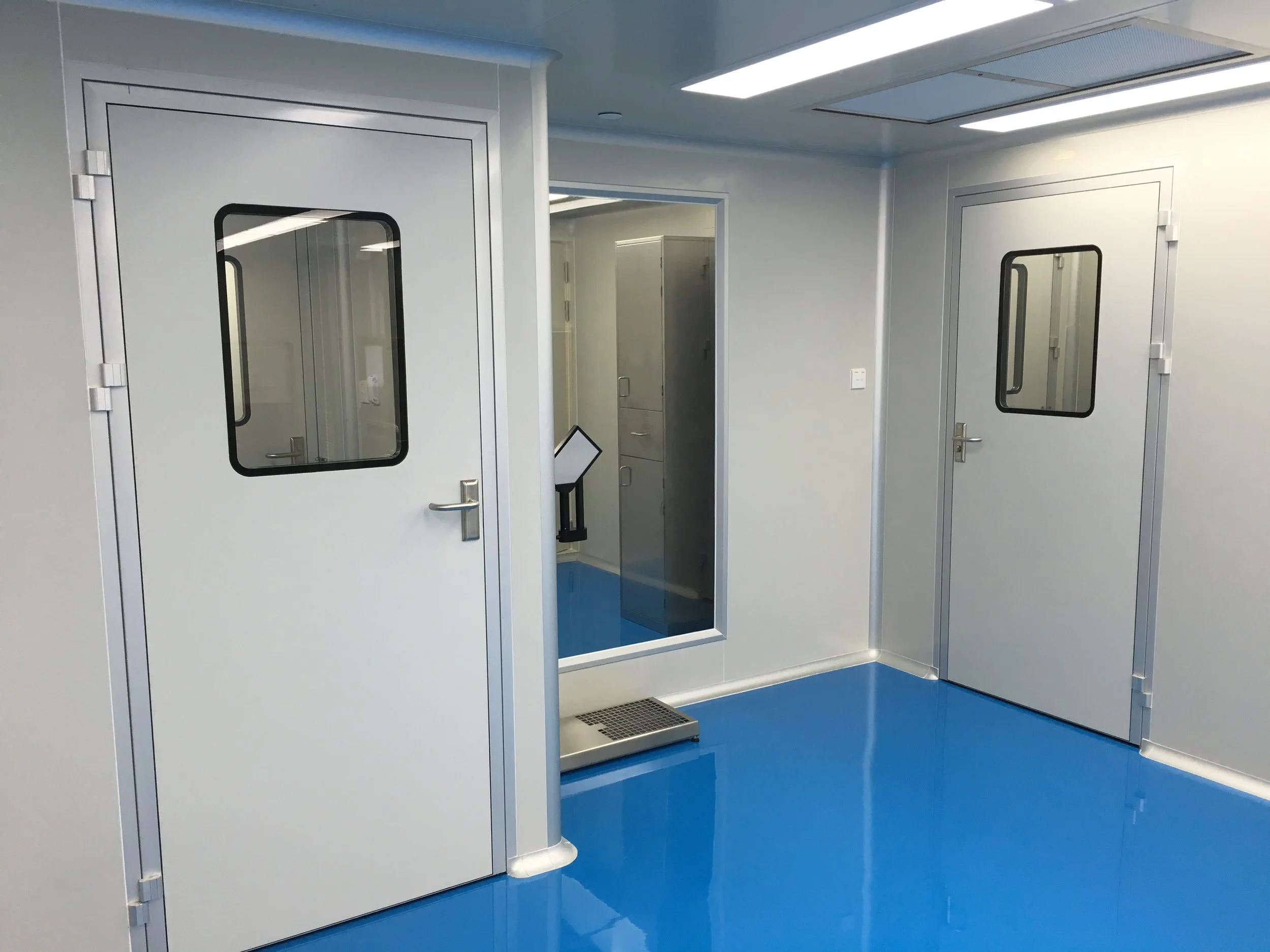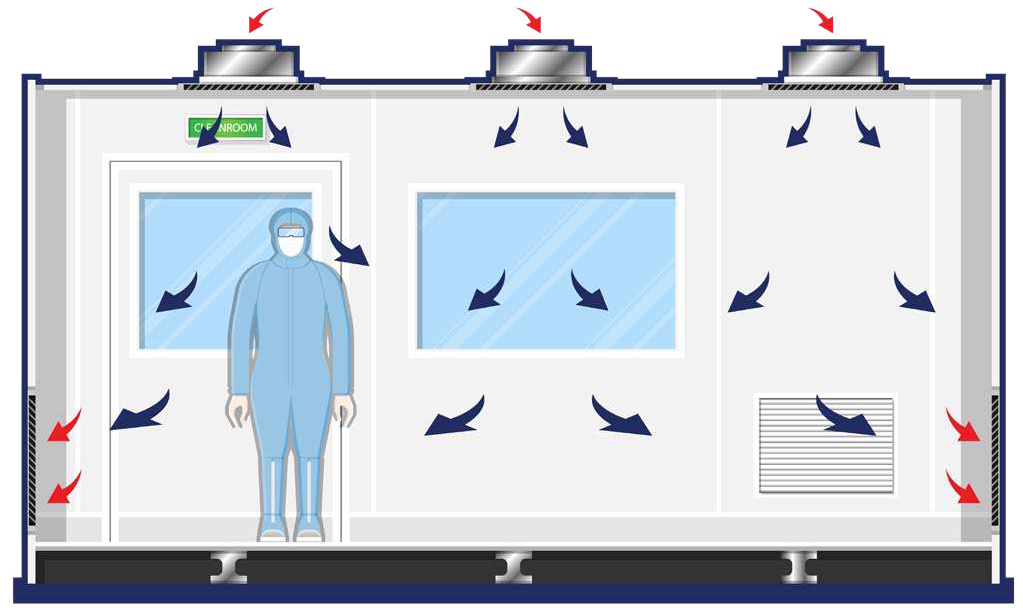Cleanrooms
A cleanroom / 無塵室 / 潔淨室 / 淨室 / 無塵車間 / 潔淨車間 is a controlled environment where the concentration of airborne particles is maintained below a specified limit per cubic foot or cubic meter. To achieve this, the rooms are engineered with state-of-the-art ventilation and filtration systems in which each component is carefully selected and placed to ensure airflow and air quality that is satisfactory for the intended use of the enclosure. Shing Shun is an expert in the design, manufacturing, and installation of many types of cleanrooms.

WHO USES CLEANROOMS?
Cleanrooms are used across a variety of industries where a clean, uncontaminated environment is required.
Some of these industries that commonly use cleanrooms are:
-
The pharmaceutical industry utilizes clean room to ensure the exclusion of contaminants in the pharmaceutical manufacturing process. The industry also uses cleanrooms to create a sterile environment for filling sterile vials, ampules, capsules, or syringes.
-
Medical devices and surgical instruments require a clean manufacturing facility to ensure no contaminants are passed patients.
-
The aerospace industry uses controlled clean environments to test and manufacture aircraft and spacecraft hardware, fine electronics, optical devices, and much more.
-
Semiconductor and microelectronics manufacturers require strictly controlled clean environments to house sensitive machinery such as photolithography, etching, cleaning, doping, and dicing machines.
-
Photographers are always in search of the clearest lenses. To prevent contaminants from being trapped inside the lens assembly, optics manufacturers assemble lenses in a controlled clean room.
-
Solar technology works at a microscopic scale. The industry even utilizes nanostructures to make solar more efficient and affordable when compared to silicon and titanium dioxide. Clean room is a necessary part of the manufacturing process to keep fine particles from damaging the nanotechnology.
-
The manufacture of e-liquids / e-juices requires that the products be produced in a clean environment. Although the regulations can be a bit enigmatic, clean room provides a level of protection against contaminants.
-
Food packaging facilities use cleanrooms to keep their food free from contaminants and germs. The packaging of food in a clean room can also help to extend the shelf-life of the packaged product.
2 CONSTRUCTION METHODS
HARD SHELL CLEANROOMS:
Modular cleanrooms / 無塵室 / 潔淨室 / 淨室 / 無塵車間 / 潔淨車間 are the most prevalent method of contemporary clean room construction. They are made of prefabricated cleanroom panels that are manufactured offsite. Proprietary coved corner for easy cleaning.
SOFT SHELL CLEAN BOOTHS:
Clean booths / 無塵棚 / 潔淨棚 are enclosures constructed of heavy metal frames suspending overlapping clear, flexible PVC films with special anti-static formulation to create a walled room. These rooms are economical and can be easily moved.
CLEANROOM AIRFLOW
Cleanrooms utilize air pressure, whether positive or negative, to control contaminants entering or leaving the room.
POSITIVE AIR PRESSURE CLEANROOM:
A positive air pressure cleanroom is an enclosure where the internal atmospheric pressure is greater than that of the exterior. This is accomplished by pumping clean air into the room, typically through the room’s ceiling.
Positive air pressure rooms keep contaminants out when a door is opened, as clean air rushes out. The external air is kept from entering the room by the room’s higher barometric pressure.
This can be likened to the air pressure in a bicycle tire. As the air in the tire is under pressure, when you release the tire’s air by depressing the valve, air isforced out, but none is allowed to enter the valve — at least not until the atmospheric pressure in the tire and the external ambient air pressure are equalized.
NEGATIVE AIR PRESSURE CLEANROOM:
A negative air pressure cleanroom is a room where the air pressure inside the room is lower than that of the air outside of the room. This is achieved by forcing air to exit the room through a filtration system. Generally, the air in a negative pressure room enters through filters near the floor and exits through filters in the ceiling or fume hood.
Negative pressure rooms are intended to keep any contaminants from escaping the room unfiltered. These rooms are used to keep harmful particles or contaminants from entering communal air.
CLEANROOM AIRFLOW
LAMINAR AIRFLOW:
Laminar airflow is defined as air that flows in a straight and unimpeded path. Also referred to as unidirectional airflow, cleanrooms utilizing laminar airflow rooms intake air using laminar airflow hoods that direct the airflow straight down to be exhausted through exhaust fans placed in the floor. Designing a laminar airflow cleanroom is a complex task. Ensuring the least amount of turbulence as the air navigates through a room of furniture, devices, and people is a matter of expert engineering and architecture.
NON-UNIDIRECTIONAL AIRFLOW:
Non-unidirectional, or turbulent, airflow rooms use non- linear airflow. This random movement of air helps to separate particles from the air and into the filtration system.

AIR FILTRATION
Cleanrooms use filters to trap dust, airborne particles, and other contaminants before they enter the room. The most used filters are HEPA and ULPA.
Both types of filters seem very similar upon first glance. Both use a dense layer of fibers and mesh to trap contaminants as air is forced through the filter. Additionally, both types of filters use the same three methods to trap airborne particles: diffusion, interception, and inertial impaction.
Although the two may seem the same, each filter has some unique characteristics that make them suitable for a variety commercial clean room applications.
ULPA FILTERS: Ultra-low particulate air (ULPA) filters are pleated mechanical filters that can trap at least 99.999% of dust, pollen, mold, bacteria, and other airborne particles with a size of 0.1 microns (0.1 µm).
HEPA FILTERS: High Efficiency Particulate Air (HEPA) filters are a pleated mechanical air filter. They are capable of trapping 99.97% of dust, pollen, mold, bacteria, and other airborne particles with a size of 0.3 microns (µm).
ULPA filters are capable of trapping smaller particles due to the dense filter material. Although this may seem like an advantage, ULPA filters allow up to 50% less air to pass, when compared with HEPA filters, resulting in fewer air changes per hour.
Classifications
Cleanrooms / 無塵室 / 潔淨室 / 淨室 / 無塵車間 / 潔淨車間 are classified by how pure the air is. Specifically, classifications are designed to categorize a clean room by the number of particles found in the lab’s air. The cleanroom classification standard ISO 14644-1 uses particular particle count measurements to categorize the cleanliness or air purity level of a clean zone or cleanroom.
Here’s some perspective.
Outside air in a metropolitan area has about 35,000,000 particles for each cubic meter within the range 0.5 μm (μm = micrometer) and bigger in measurement, which is the equivalent of an ISO 9 cleanroom. On the other end of the ISO spectrum, an ISO 1 cleanroom allows no particles in that range (0.5 μm and bigger in measurement), and only 12 particles for each cubic meter that is 0.3 μm and smaller.
Cleanrooms are categorized according to both the size and the number of particles present per volume of air. ISO 14644-1 standards specify the decimal logarithm of the number of particles 0.1 µm or larger present per cubic meter of air.
ISO 1 for instance, has at most 10 particles per m³ (cubic meter) and ISO class 4 cleanroom has at most 10,000 particles per m³.
ISO 14644-1 cleanroom standards
US FED STD 209E cleanroom standards
The cleanliness of a cleanroom is defined by ISO-14664 standards. These standards, written by the International Organization for Standardization, were first derived from the US Federal Standard 209E Airborne Particulate Cleanliness in Cleanrooms and Clean Zones in 1999.
As of November 29th, 2001, the Federal Standard 209E has been replaced with ISO 14644-1. The number assigned to the class is the classification to which the room must be designed to. In the Fed. Standard 209E, Class 1 was the cleanest; the new ISO 14644-1 Standard, Class 3 is the cleanest. The federal standards were measured in cubic feet, and the ISO standards are measured in cubic meters.
Class 3, 4, and 5 ISO standards are based on the maximum number of 0.1 and 0.5 micron particles that are permitted in a cubic foot of air approaching any work operation within the room. Class 6, 7, and 8 are based on the number 0.5 micron particles. One micron is one-hundredth the width of a human hair. The smallest particle seen with the naked eye is a 10 micron particle.









